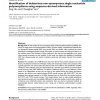17 search results - page 3 / 4 » Protein Structure Prediction: Selecting Salient Features fro... |
BMCBI
2010
14 years 11 months ago
2010
Background: Type III secretion system (T3SS) is a specialized protein delivery system in gramnegative bacteria that injects proteins (called effectors) directly into the eukaryoti...
BMCBI
2010
14 years 11 months ago
2010
Background: Time-of-flight mass spectrometry (TOF-MS) has the potential to provide non-invasive, high-throughput screening for cancers and other serious diseases via detection of ...
114
click to vote
BMCBI
2010
14 years 11 months ago
2010
Background: It is well known that most of the binding free energy of protein interaction is contributed by a few key hot spot residues. These residues are crucial for understandin...
114
click to vote
JMLR
2011
14 years 6 months ago
2011
We propose a framework MIC (Multiple Inclusion Criterion) for learning sparse models based on the information theoretic Minimum Description Length (MDL) principle. MIC provides an...
BMCBI
2008
14 years 11 months ago
2008
Background: As the number of non-synonymous single nucleotide polymorphisms (nsSNPs), also known as single amino acid polymorphisms (SAPs), increases rapidly, computational method...

